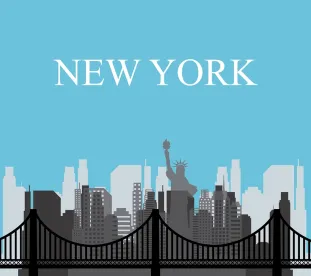On Oct. 31, 2020, the state of New York changed its policy on individuals traveling into New York state from other states. New York has determined that the former standard of a seven-day rolling average of over 10% of all Coronavirus Disease 2019 (COVID-19) tests producing a positive result, or the number of positive cases exceeding 10 per 100,000 residents, is no longer feasible. Previously, the list of states on the Travel Advisory List was updated weekly based on cases in each state over time. Individuals were required to quarantine for 14 days upon entry into New York after traveling for 24 hours or longer from designated states that had significant rates of COVID-19 transmission; Essential Workers were exempt. Going forward, there will be no state quarantine list; there will be one rule that applies across the country.
The New Regulations
The new protocol, effective Wednesday, Nov. 4, will allow an alternative to the mandatory 14-day quarantine. Travelers from states that are contiguous with New York will continue to be exempt from the travel advisory (you may continue to travel freely between NY and CT/MA/NJ/PA/VT); however, covered travelers must continue to fill out the Traveler Health Form. Essential workers will continue to be exempt.
For out-of-state travelers to New York state other than the contiguous states, the new guidelines for travelers to test out of the mandatory 14-day quarantine are below:
For travelers who were in another state for more than 24 hours before entering New York state:
-
Travelers must obtain a COVID-19 test within three (3) days of departure from that state.
-
Travelers must, upon arrival in New York, quarantine for three (3) days.
-
On day four (4) of their quarantine, travelers must obtain another COVID-19 test. If both tests come back negative, travelers may exit quarantine early upon receipt of the second negative diagnostic test.
For travelers who were in another state for less than 24 hours before traveling into New York state:
Travelers do not need a test prior to their departure from the other state and do not need to quarantine upon arrival in New York state. However:
-
Travelers must fill out the Traveler Health Form upon entry into New York state, and take a COVID-19 diagnostic test four (4) days after their arrival in New York.
Local health departments will validate tests, if necessary, and if a test comes back positive, they will issue isolation orders and initiate contact tracing. The local health department must contact the state the traveler came from, to ensure contact tracing proceeds in that other state as well. All travelers must continue to fill out the traveler form upon arrival into New York state to contribute to New York state’s contact tracing program.
There is a medical exemption to New York’s quarantine rule which allows those under quarantine to leave their homes for a medical procedure, elective procedure, or other appointment that cannot be postponed.
Anyone currently in quarantine under the present New York state travel advisory should continue to do so under the current rules until their quarantine period ends.
Rules for International Travelers
On Sept. 28, 2020, Gov. Cuomo signed an executive order reminding international travelers entering New York from Level 2 and 3 countries to quarantine and fill out the Traveler Health Form to further prevent the spread of COVID-19.
The New York State Commissioner of Health has expanded his Emergency Health Order, which authorizes the imposition of civil penalties if individuals refuse to fill out the required form.
Since March 2020, New York state has required a mandatory quarantine for any traveler entering New York from a Level 2 or Level 3 country. That list includes all but 31 countries around the world. See a list of the 31 countries/territories NOT subject to the governor’s executive order and mandatory quarantine requirement.
Precautionary Quarantine Requirements
Shelter Requirements Precautionary Quarantine
-
The individual must not be in public or otherwise leave the quarters that they have identified as suitable.
-
Separate quarters with separate bathroom facilities for each individual or family group. Access to a sink with soap, water, and paper towels is needed.
-
The contact must have a way to self-quarantine from household members as soon as fever or other symptoms develop, in a separate room. The room must have its own bathroom and a door that separates it from the rest of the living area. Given that an exposed individual could become ill while sleeping, the exposed individual must sleep in a separate bedroom from household members.
-
Cleaning supplies, e.g., household cleaning wipes, must be provided in any shared bathroom.
-
If an individual sharing a bathroom becomes symptomatic, all others sharing the bathroom will be considered exposed persons until the symptomatic individual is appropriately evaluated and cleared.
-
Food must be delivered to the individual’s quarters.
-
Quarters must have a supply of face masks for individuals to put on if they become symptomatic.
-
Garbage must be bagged and left outside by the door of each of the quarters for routine pick up. Special handling is not required.
-
Individuals should self-monitor daily for fever and other symptoms of COVID-19 throughout the duration of the quarantine period.




 />i
/>i

